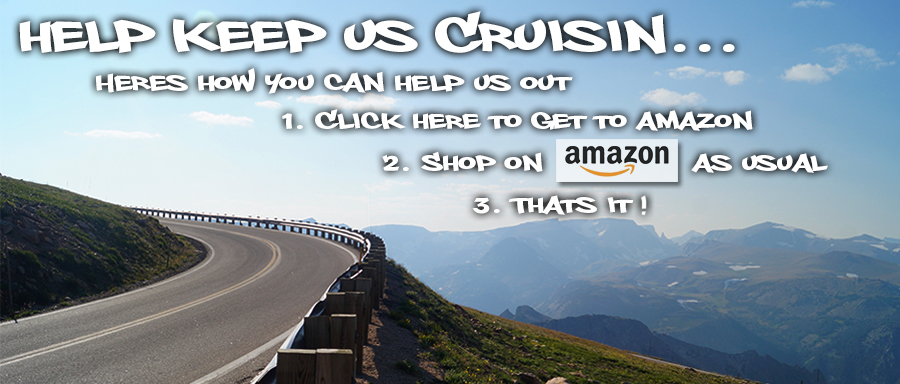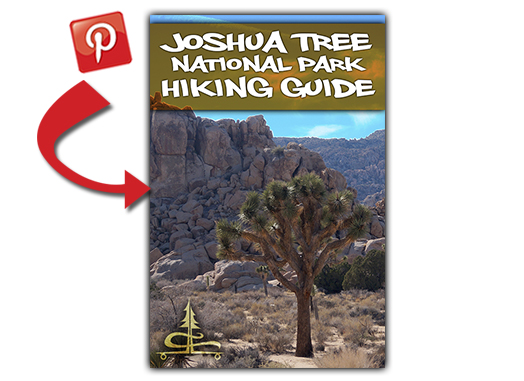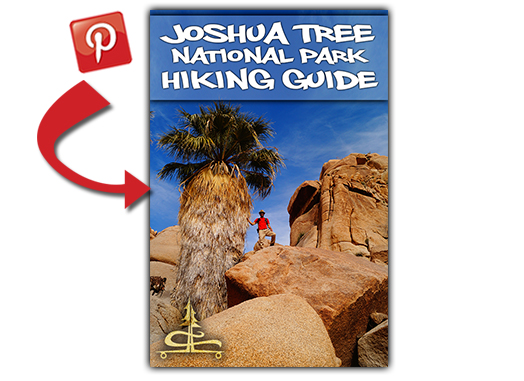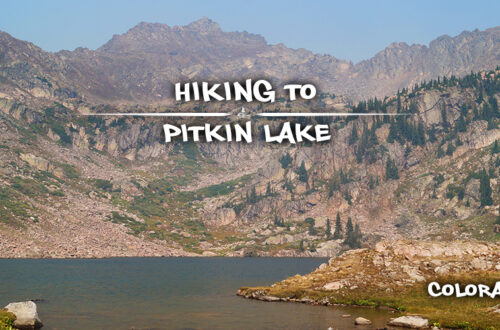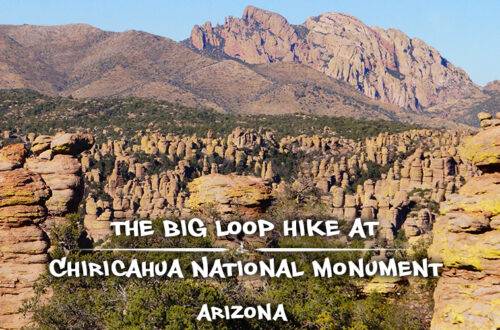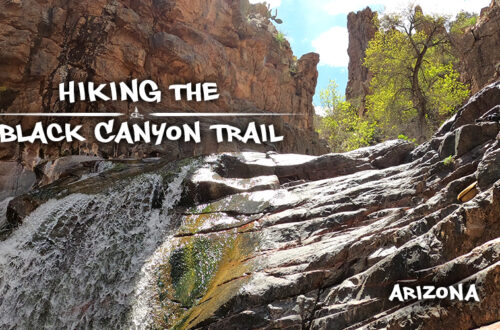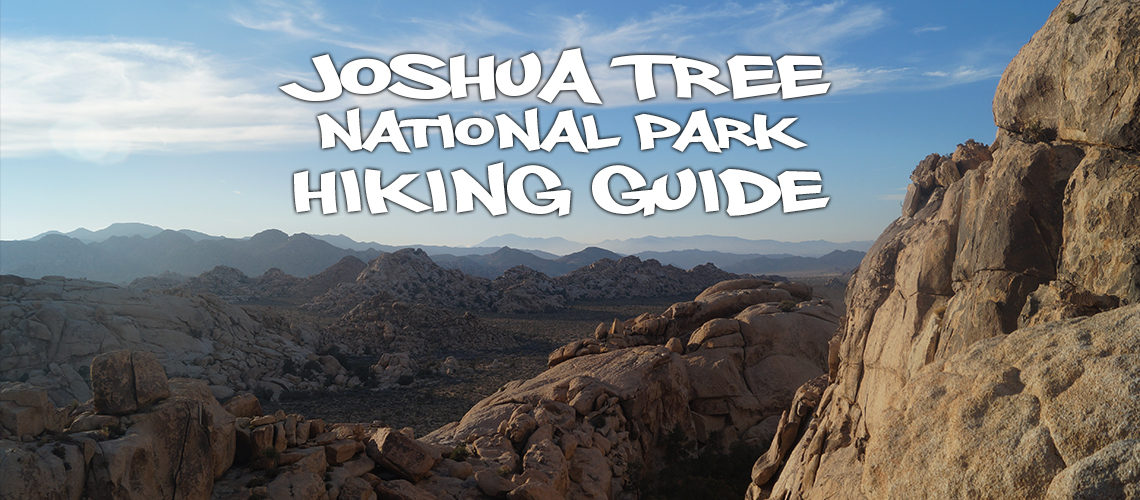
Hiking in Joshua Tree Guide
For those who love the outdoors, hiking in Joshua Tree National Park is a must! Hikes in Joshua Tree vary from easy to strenuous, from short trails to overnight trips, and from rugged peaks to desert oases.
Along with the many opportunities for hiking in Joshua Tree, there are lots of other activities to do in the national park. For instance, there are endless scrambling opportunities, as well as opportunities for rock climbing, mountain biking, backpacking, and stargazing.
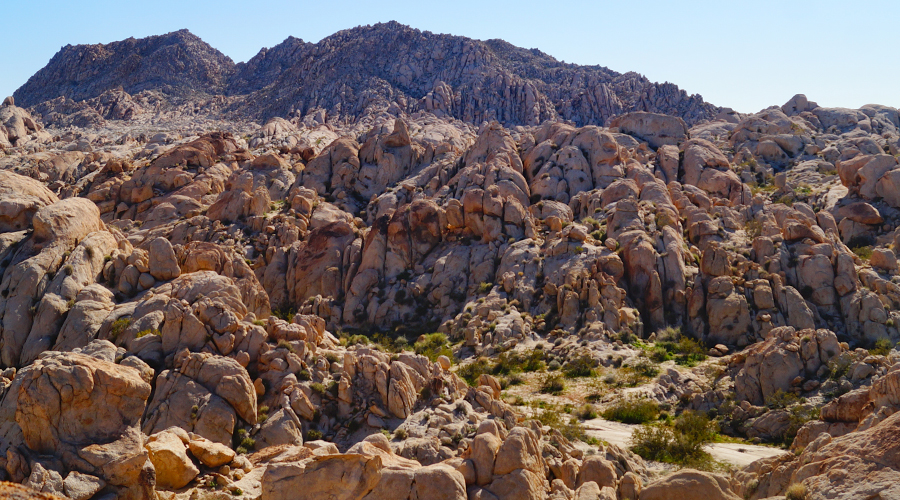
Joshua Tree National Park protects almost 800,000 wild and scenic acres that make up a glorious playground to explore! It lies where the Colorado and the Mojave Deserts meet and the differences between the two blend to make a very intriguing desert landscape.
The Mojave Desert is to the north and has a higher elevation as well as a greater diversity of plants. In contrast, the Colorado Desert to the south has lower elevation and wicked cool gardens of cacti.
As a result, hiking in Joshua Tree exposes to us a special place that holds endless adventure, beauty, and solitude. Joshua Tree is a unique place to visit and the area leaves a lasting impression on many of its visitors.
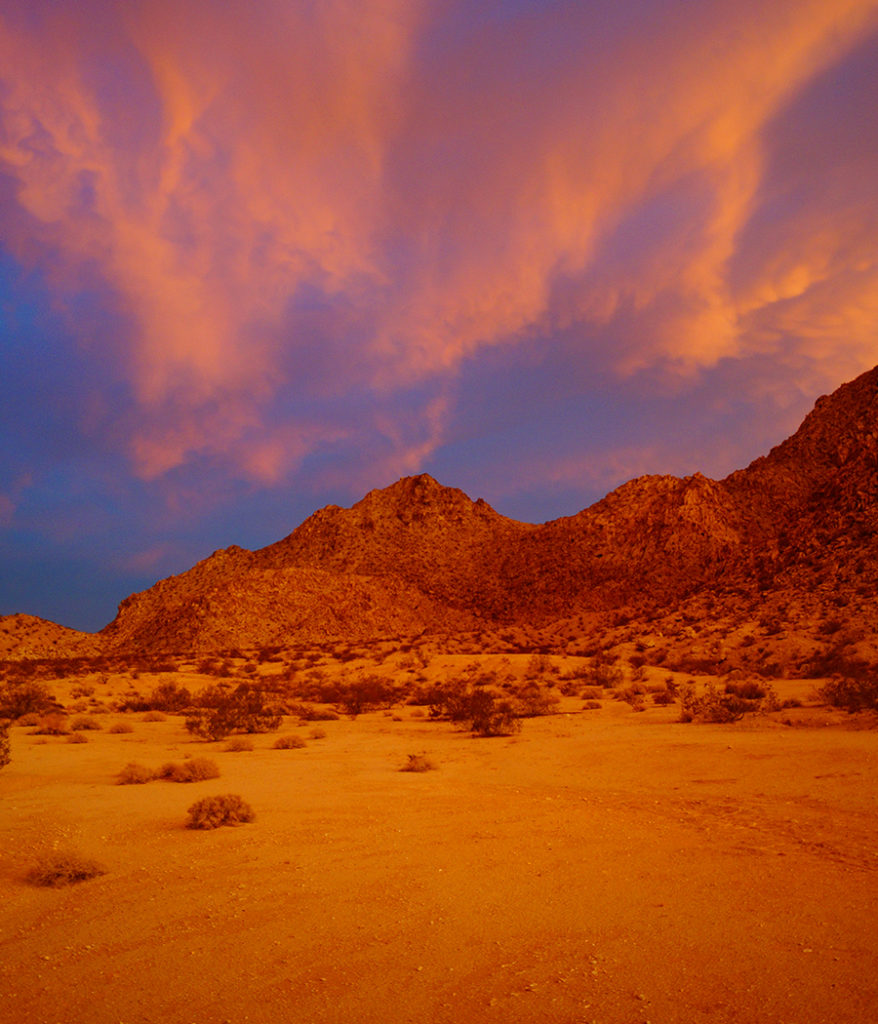
The hikes in this guide include noteworthy areas to explore in the national park, although there are endless others out there to discover! In addition to information about hiking in Joshua Tree, this guide provides further information about things to do in Joshua Tree, where to stay in Joshua Tree, the best campgrounds in Joshua Tree and other park information.
Know what you’re looking for? Jump ahead to:
- Hiking in Joshua Tree
- Things to do in Joshua Tree
- What is a Joshua Tree?
- Joshua Tree National Park Visitor Centers
- Map of Joshua Tree National Park
- Joshua Tree National Park Weather
- Best Campgrounds in Joshua Tree
- Where to Stay in Joshua Tree
- Restaurants in Joshua Tree
Hiking in Joshua Tree
Hiking in Joshua Tree is a truly unique experience. Together, the vast landscape, enormous heaps of massive boulders, and the dancing Joshua Trees seemingly full of personality are reason enough to head to Joshua Tree National Park! Many visitors come to the park not really knowing what to expect and leave thoroughly amazed.
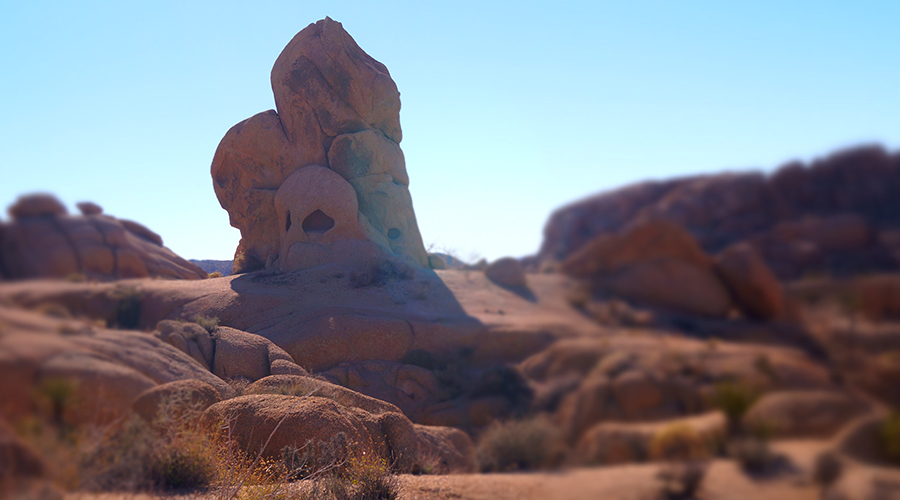
Hiking in Joshua Tree summons up adjectives such as “other worldly”, “amazing”, and “like being on another planet”. Joshua Tree hikes have something for everybody and do not disappoint!
You can find trails of varying lengths and difficulties as well as a multitude of different experiences on the trails. For instance, one can find hiking in Joshua Tree that leads to historic old mines, scenic overlooks, magical palm oases, and playful areas where you can immerse yourself in or on massive boulders.
Here are some awesome trails to check out for a great experience hiking in Joshua Tree!
- Hall of Horrors
- There is a marked parking area located on the north side of Park Blvd between Ryan Campground and Sheep Pass Campground.
- This is a short loop around a fun rock formation that allows you to squeeze between and inside of the rocks that make up the huge rock pile. You can find a narrow hallway formed between two massive boulders and you can also scramble to the top of the pile. There are rock climbing routes here as well.
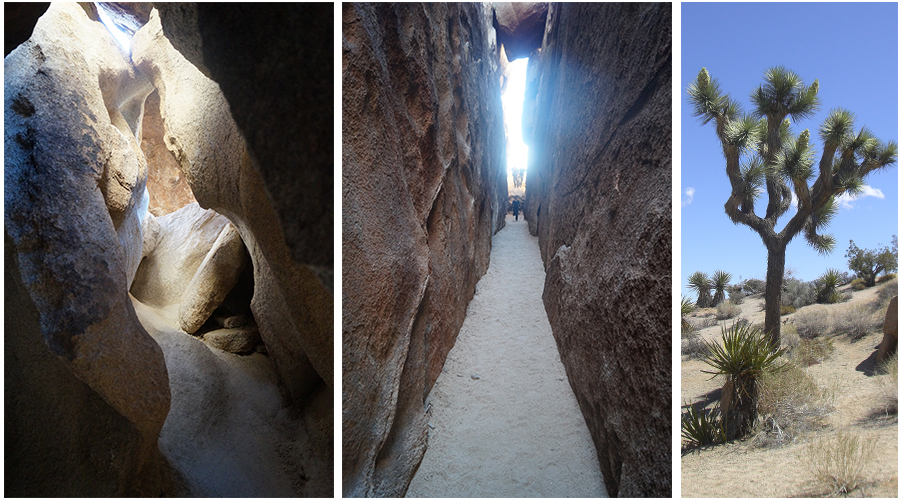
- Boy Scout Trail
- To get to the registration board within the park: from the Joshua Tree entrance booth, head 6.5 miles along Park Blvd to the signed Boy Scout Trail trailhead. Or to get to the registration board on the Indian Cove side: turn south off of the CA-62 towards Indian Cove Campground for 1.5 miles and the parking will be on the right. If you’re backpacking, be sure to register.
- Boy Scout Trail is about 8 miles one way. This is often done as a backpacking trail or a shuttle hike. This is a great trail to experience backcountry camping in Joshua Tree National Park with lots of great spots to pitch a tent, find solitude and immerse yourself in the stars. This trail passes through canyons, Joshua Trees and awesome boulders! And if you allow yourself enough time there’s lots of climbing, scrambling and exploring to do when you’re not through hiking.
- Arch Rock
- This trail can be accessed from Twin Tanks parking area on the west side of Pinto Basin Road north of White Tank Campground or near site 9 in White Tank Campground.
- Arch Rock Trail is a short interpretive hike through gorgeous boulders with a very photogenic arch formation. There are a lot of cool boulders in this area and it’s a great place to get off the trail and play on the rocks for a bit.
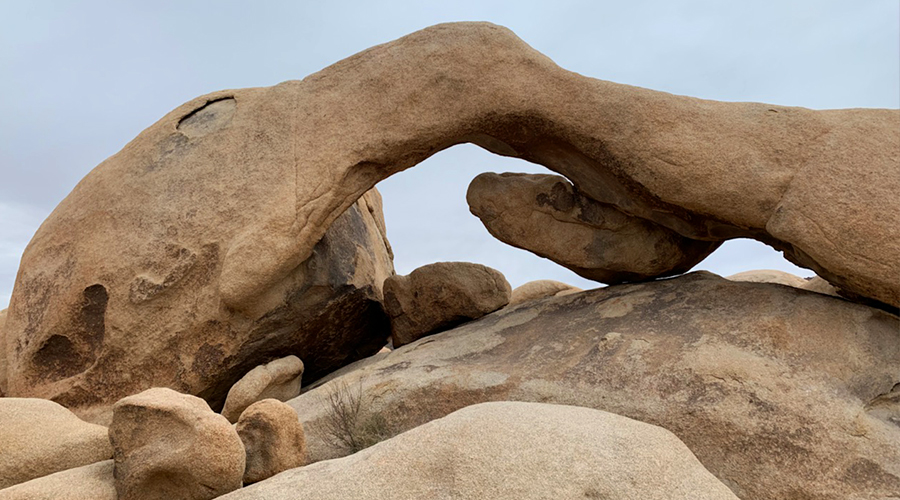
Like this article? Pin it!
- Willow Hole Trail
- From the Joshua Tree entrance booth, head 6.5 miles along Park Blvd to the signed Boy Scout Trail trailhead. After 1.2 miles, Willow Hole Trail branches off of Boy Scout Trail.
- This is a mellow and beautiful hike in Joshua Tree that encounters massive boulders in the Wonderland of Rocks, small streams and watering holes as well as great biodiversity! The scenery is visually stimulating and the climbing/scrambling opportunities are plentiful.
- Ryan Mountain
- There is a designated Ryan Mountain Trail parking area located right off of Park Blvd between the Hall of Horrors parking area and Sheep Pass Campground.
- Hiking in Joshua Tree comes in many different forms, so here’s a classic summit hike to check out! To begin with, this is a steep but short hike to the top of Ryan Mountain. From here, you are rewarded with an unbeatable panoramic view overlooking the massive piles of boulders and the vastness of the national park.
- Pine City Trail
- From Park Blvd, take Desert Queen Mine Road 1.3 miles north to the parking area and trailhead.
- This is a less crowded hike in Joshua Tree through a beautiful desert setting that leads to huge boulders and canyons for continuing your exploration as the designated trail ends. There is also an abundance of plant life to enjoy along this trail.
- Hidden Valley Trail
- From Park Blvd, turn southwest towards Hidden Valley Picnic Area to find the trailhead. From Barker Dam Road, at the intersection past Hidden Valley Campground turn north on Park Blvd and then southwest towards Hidden Valley Picnic Area.
- This is a great introductory short loop hike through a gorgeous valley of boulders and unique rock formations. There are informative signs along the trail as well as countless opportunities for rock climbing and scrambling. A great place to stop to get a quick feel for the beloved Joshua Tree boulders.
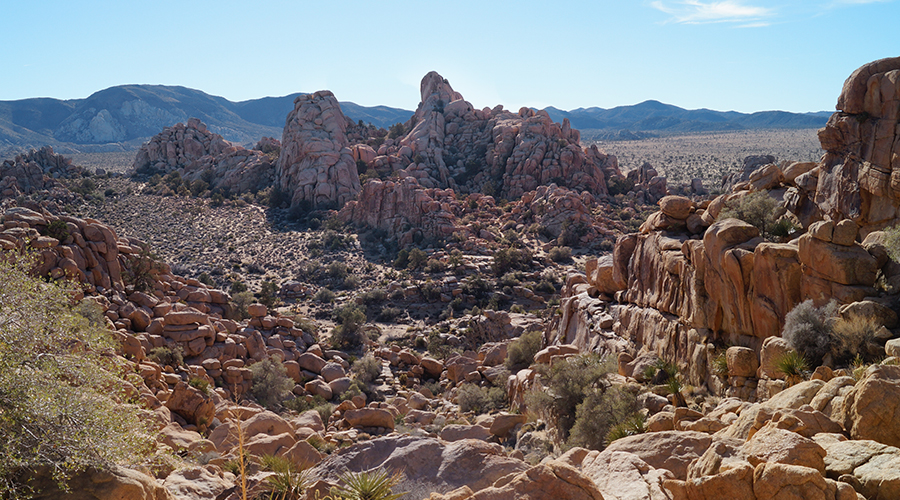
Oasis Hikes
- Lost Palms Oasis
- From the Cottonwood Visitor Center near the south entrance of Joshua Tree National Park, take Cottonwood Oasis Road southwest for about a mile to a parking area. It is often busy and you may have to park along the road.
- Lost Palms Oasis Trail is a great option if you’re looking for something longer and rewarding. The trail becomes less busy after the turnoff for Mastodon Loop Trail which can be added on to the Lost Palm Oasis Trail if you’ve got extra energy. Lost Palms Oasis trail is a moderate trail to a steep descent that leads to a palm oasis. The trail is long but engaging with beautiful views all around so it truly is about the journey not the destination! Once to the palm oasis there is plenty of scrambling further up the canyon to check out. This area is also gorgeous during wildflower season.
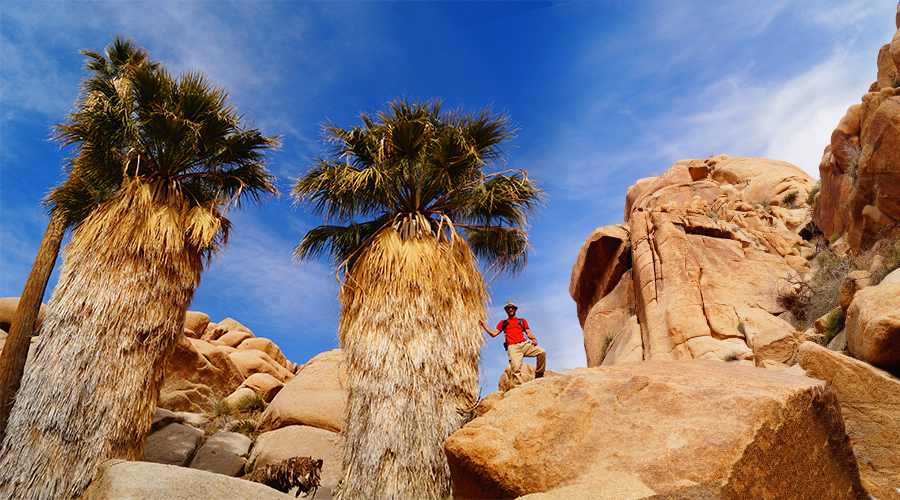
- Fortynine Palms Oasis
- There is a sign on the CA-62 indicating the access road for the Fortynine Palms Oasis hike. Here, turn south onto Canyon Road near the VCA Animal Hospital. Follow the road to the a designated day use parking area.
- This is a very enjoyable hike in Joshua Tree through the beautiful desert terrain to a cool palm oasis. The trail does gain some elevation before descending to the oasis and allows for a nice vast overlook of civilization below. Once at the oasis, you can scramble further up the canyon which we found to be very enjoyable and peaceful.
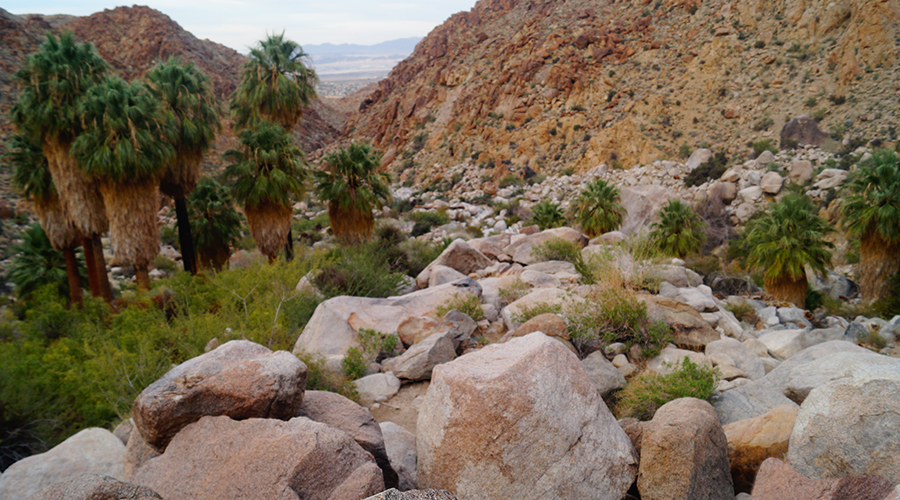
More Hikes with Water
- Rattlesnake Canyon
- The trail is accessed via Indian Cove and starts at the designated day use parking and picnic area. Start by going left at the first Indian Cove intersection and follow the gravel road past the campsites to your destination. There are vault toilets, picnic tables and grills.
- This is a very fun and unique Joshua Tree hiking experience. Follow the rocky canyon (and hopefully the small stream of water) to a cool grotto area with a small pool and waterfall. Climb further up the boulders to where you can look over the top of the waterfall (or dryfall). If you keep exploring the canyon, it does level out a bit and you may find more water that, at times, is deep enough to jump in. On top of that, there is also endless rock scrambling opportunities.
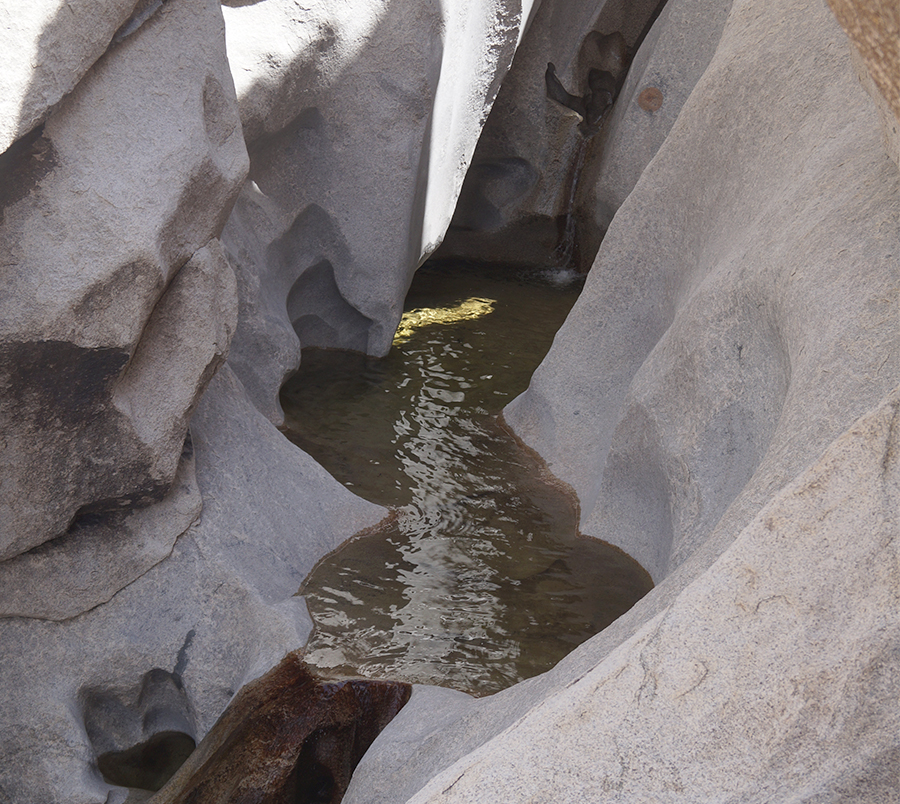
- Barker Dam
- Coming east on Park Blvd, turn northeast onto Barker Dam Road, just passed Hidden Valley Picnic Area, and follow it to the large parking area. Coming west on Park Blvd, turn northwest on Big Horn Pass Road which then heads west on Queen Valley Road and the parking area will be on the right.
- Barker Dam is an enjoyable hike in Joshua Tree through the desert to a beautiful dammed area surrounded by huge rocks. It’s always a treat to see water in the desert and to top it off, there’s plenty of boulders to climb around on. Be sure to read the informative signs as you walk along the trail.
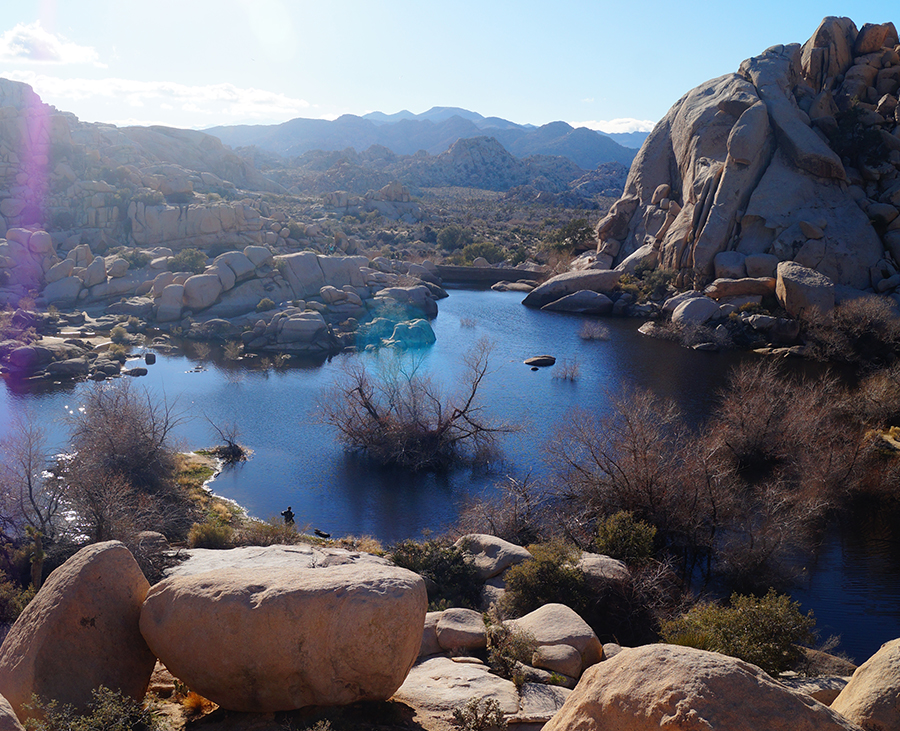
Short, Easy and Awesome Hikes
- Cholla Cactus Garden
- Take Pinto Basin Road south about 10 miles from the intersection with Park Blvd to the large designated parking area.
- Who knew that an area with thousands of cholla cacti could be so visually appealing? A must see for hiking in Joshua Tree. Take a stroll on the designated trails through a dense cactus garden. Be aware of your surroundings and grab an interpretive brochure at the trailhead if you can. This is usually a busy area.
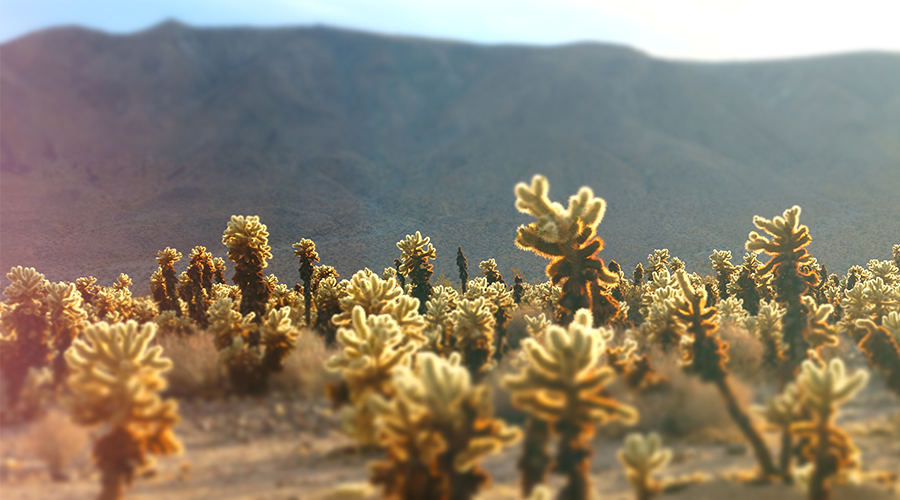
- Keys View to Inspiration Point
- West of Ryan Campground from Park Blvd take Keys View Road south for 7 miles to the overlook parking area.
- At Keys View there is a large parking area and cement sidewalks to the overlook. From here there are great views overlooking the desert. Or make it challenging for an even better vantage point, you’ll notice a steep unmarked trail heading up to a nearby high point.
- Skull Rock
- You can get to Skull Rock from Jumbo Rocks Campground. If you’re coming from Twentynine Palms, there is a designated roadside parking area 11.5 miles from the CA-62.
- Hiking in Joshua Tree wouldn’t be complete without sparing 15 minutes to capture your own photo of this skull like rock formation. Be warned, this trail and the road nearby are almost always rather crowded. If you’re staying in the nearby Jumbo Rocks Campground, this makes for a convenient dusk/night hike!
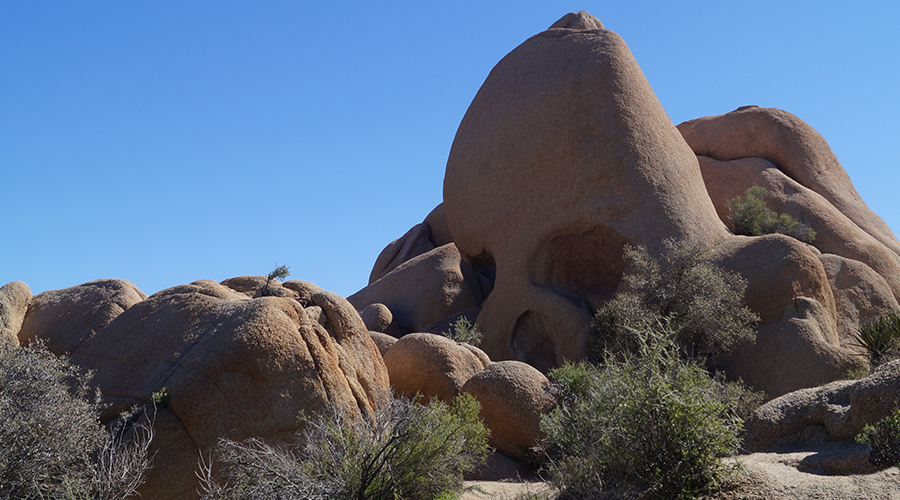
Hikes with Historic Ruins
- Lost Contact Mine
- Go half a mile past the Twentynine Palms park entrance booth. Park here in the small signed parking area on the southwest side of Utah Road. Then, hike southwest past the information sign to pick up the trail.
- This is a mellow, medium length lightly trafficked trail to old mine remains and other rusty remnants. The trail itself is very enjoyable and peaceful with pretty views of the surrounding desert area.
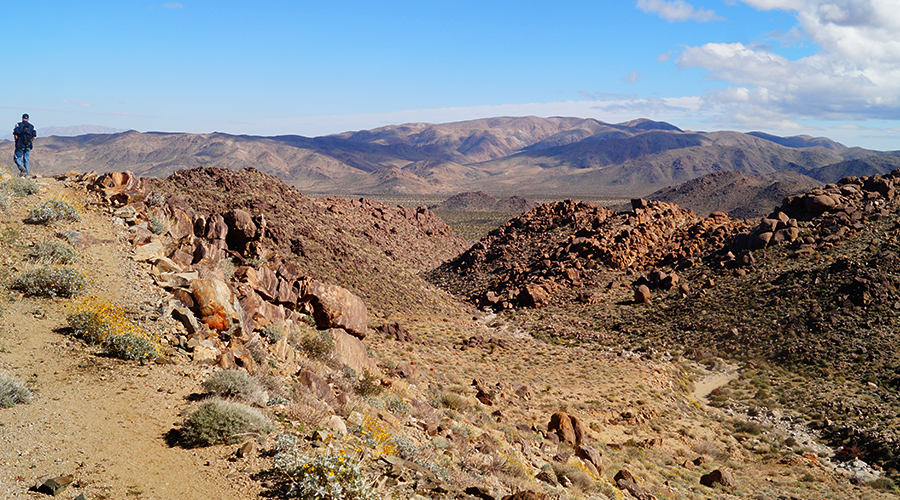
- Ryan Ranch
- Access this trail from Ryan Campground or from a turnout just east of the Ryan Campground entrance on the south side of Park Blvd.
- This is a short historic hike in Joshua Tree that leads to the old ruins of a homestead from over a hundred years ago. You can find the remains of an old adobe home here as well as other structures and artifacts.
- Lost Horse Mine Loop
- West of Ryan Campground from Park Blvd take Keys View Road south for 2.4 miles. Then turn left onto Lost Horse Mine Road. Follow Lost Horse Mine Road for 1 mile and park here.
- The Lost Horse Mine hike in Joshua Tree is a great hike to cross off the list after you’ve checked out a few others first. This trail has quite a few perks. For instance, it is a loop, a good workout and rewards you with vast views overlooking Pleasant Valley. It also is said to contain one of the best preserved mills of its kind inside of any National Park.
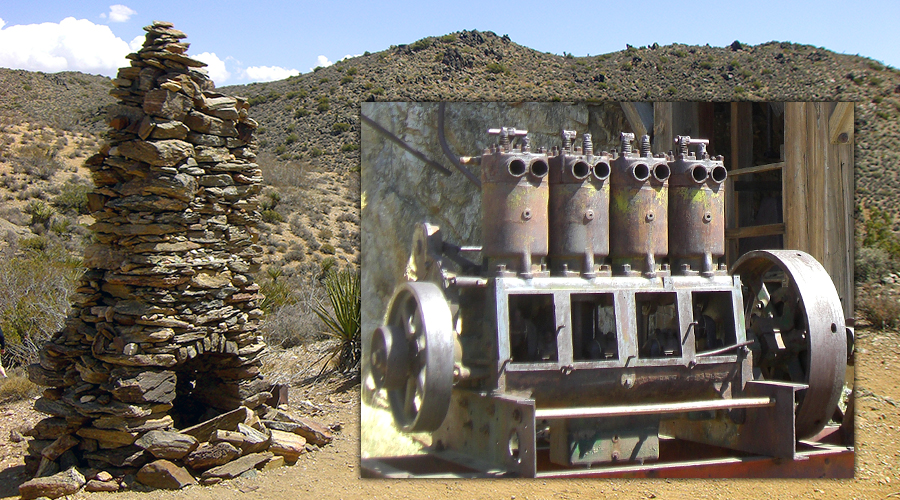
Are you packing your bags yet?
As you can see, hiking in Joshua Tree disproves the popular misconception that the desert is flat, without beauty and that there’s nothing to do. If you can see it my way, Joshua Tree National Park is a giant playground where one can play all day, discover natural wonders and find peace at any given time.
Did you enjoy learning about the many opportunities for hiking in Joshua Tree? And now do you want to explore the national park further? You’ll be happy to know that there is a variety of additional things to do in the park!
Things to do in Joshua Tree
After learning about some of the exciting hiking in Joshua Tree and getting a feel for the park, you may be wondering how else can you experience even more of the national park. Luckily, there is no shortage of things to do in Joshua Tree. Read on to learn how you can explore Joshua Tree by foot, by rope, by bike or with four wheel drive!
You may choose from the following menu if you see particular things to do in Joshua Tree that interest you.
- Joshua Tree Climbing and Bouldering
- Highlining and Slacklining in Joshua Tree
- Scrambling in Joshua Tree
- Joshua Tree Stargazing
- Joshua Tree Backpacking
- Horseback Riding in Joshua Tree
- Biking in Joshua Tree
- Exploring Joshua Trees Backroads
- Ranger Programs in Joshua Tree
- Wildflowers in Joshua Tree
Joshua Tree Climbing and Bouldering
Almost as significant as the Joshua Trees are to Joshua Tree National Park are the behemoth boulders that can be found in massive piles, rugged canyons and stacked rock peaks. Visitors come from near and far to take advantage of an area so rich with climbing routes. And the possibilities are seemingly endless!
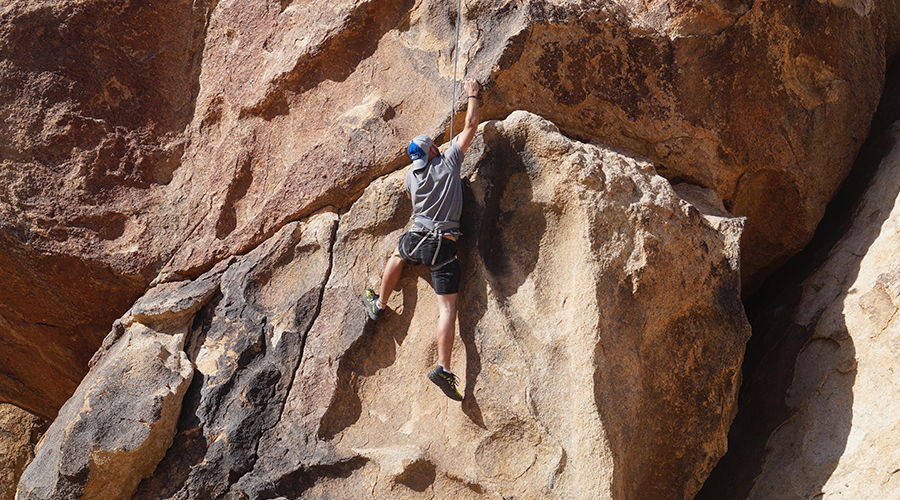
Routes of all styles and difficulties and can be found in Joshua Tree. A Joshua Tree Climbing guide book can be really helpful to help you find routes of specific styles and difficulties. Not looking for anything specific? You’ll likely be able to spot bolted routes as well as top rope areas that you may be interested in trying out. On some hiking trails, such as Hall of Horrors, there may be signs pointing out designated and popular routes in the area.
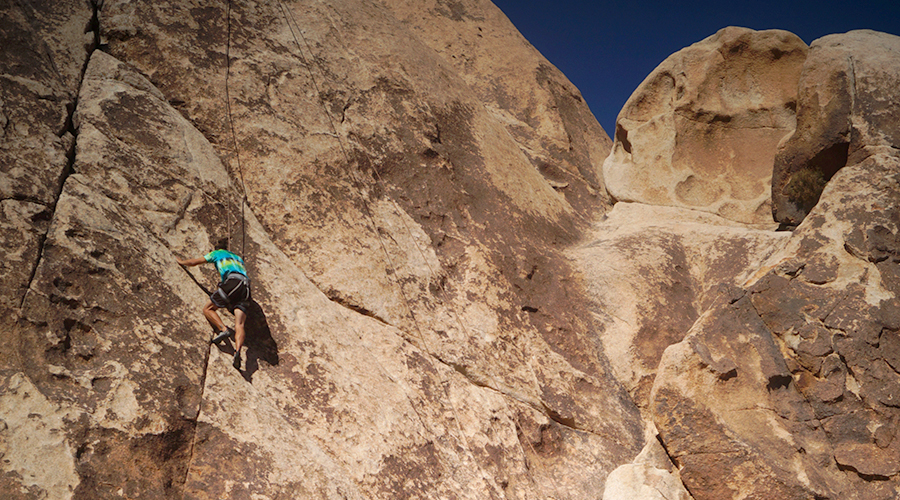
If you’ve never climbed in Joshua Tree, it’s important to know the rules of the national park. There are designated rules about hiring climbing guides as well as in regards to the placement of fixed anchors. For instance, before hiring a climbing guide, be sure that they are permitted to work in Joshua Tree National Park. To get more information about climbing guide requirements and for a list of permitted guides click here.
Additionally, in some cases the placement of additional bolts/fixed anchors or the use of power drills may require a permit. You can read up on the rules and regulations to see if you need a permit here.
Highlining and Slacklining in Joshua Tree
While visiting the park you may see people walking on what seems like thin air high above you between two huge boulders. This is called highlining, and the lower version of this activity is called slacklining. Both are very similar to tight rope walking. There is a thin webbing attached to two anchor points. One tests their balance as they walk (and may do a variety of tricks) along the length of the webbing.
Of course, if you’re into highlining and slacklining, it seems only natural that Joshua Tree would be a great place to show off and test your skills. Both of these activities are welcome in the park as long as the park’s rules and regulations are followed. In Joshua Tree National Park, slacklines cannot be anchored to vegetation, are not allowed in campgrounds, and may not be left fixed or unattended. To read the rules regarding anchoring and power tools, you can find them on the national park site here.
Scrambling in Joshua Tree
Scrambling on the beautiful, massive, and inviting boulders in Joshua Tree is one of the most enjoyable activities in the park in my opinion! So much so, that it’s hard not to participate in this activity. Oftentimes, hiking in Joshua Tree and rock scrambling go hand in hand.
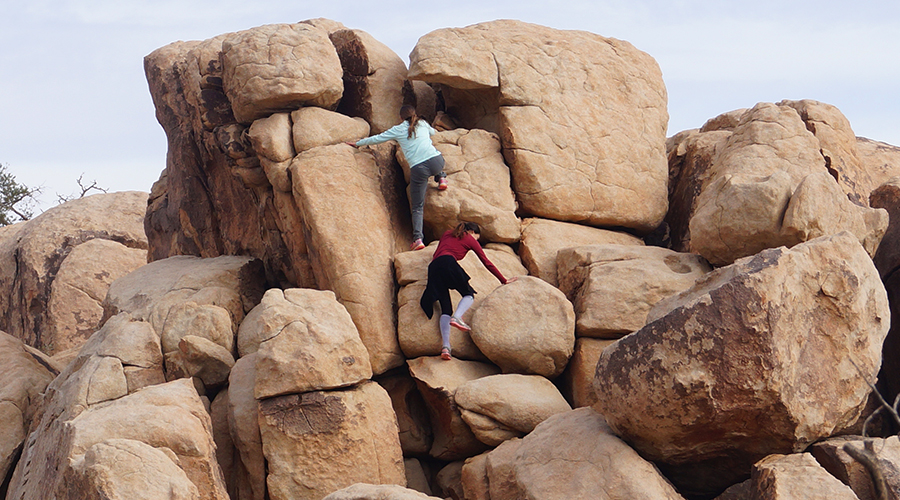
Scrambling can be done on hikes that steer you amongst the boulders, at many of the campgrounds in Joshua Tree National Park or as a designated activity. There are areas in the park that have random towering piles of boulders as well as whole series of canyons made up of boulders. Sometimes, instead of setting off on a designated trail we’ll just pick a rocky area and start climbing and jumping from rock to rock for as far as we want.
Joshua Tree Stargazing
Besides being an amazing and magical place to explore during the day, Joshua Tree is also an excellent place to enjoy the dark night sky. Especially if you’re coming from nearby Los Angeles or San Diego, the number of the stars visible in the sky will blow your mind! The clear desert night skies offer visitors to the park an opportunity to see a sky so full of stars and the impressive Milky Way!
When planning your trip to the desert, keep in mind that the Milky Way is best seen during the summer months and the dark sky is most impressive during the New Moon phase or when the moon is the least full. Even so, stargazing in Joshua Tree at anytime is unlikely to disappoint.
Some areas of the park have less light pollution than others. For instance, the area near the Cholla Garden along with the Cottonwood Springs area. The campgrounds in the park are great for stargazing. Also, you can choose from a number off pull offs throughout the park to view the stars from. Even more ideal is a night hike to a low traffic area tucked away from the light pollution of the big cities to the west..
If you’re interested in looking at the many night sky treasures through telescopes with knowledgeable people nearby, check out the observatory in Twentynine Palms called Sky’s the Limit. Sky’s the Limit is located just outside of the Twentynine Palms park entrance. There are free star parties on Saturdays when there is not a full moon. They also offer other free scheduled events that you may be interested in. You can learn more about Sky’s the Limit, their calendar of events and the event details at their website.
Joshua Tree Backpacking
If you believe that hiking in Joshua Tree is best experienced away from the crowds and busy parking areas then planning to backpack in the national park is a great option for you! This is a great way to see the park and stumble upon little treasures that you may have missed driving from attraction to attraction.
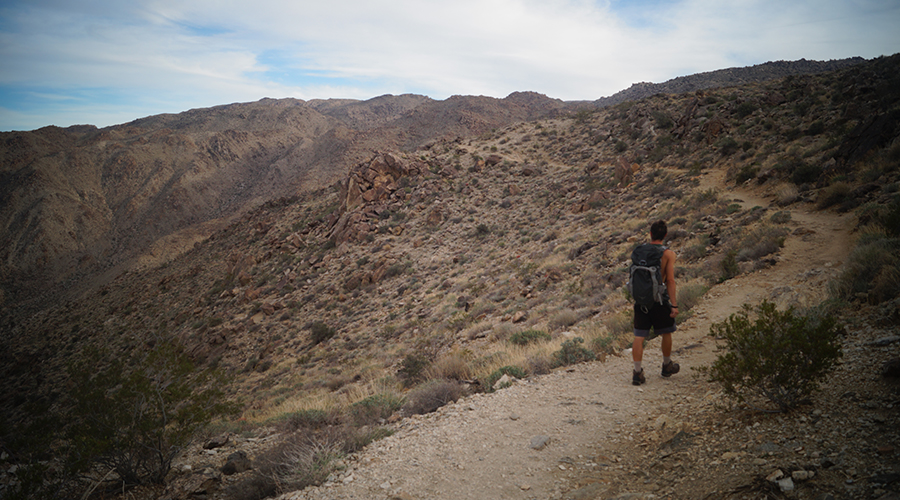
As mentioned in the backcountry camping section, there are 13 designated backcountry parking areas and registration boards throughout the park. Be sure to register; an unregistered vehicle in the parking areas may be towed or cited. Also note that some areas are day use only. Refer to the backcountry camping section below for choosing your camp spot while out backpacking.
As water in Joshua Tree is not available, caching food and water for multiday backpacking trips is allowed. The items may be cached for up to 14 days. Make sure your cache is marked with your name, contact information and date. Also, be sure to pack layers because the weather in the desert can span 30-40 degrees in a day, easy.
A few of the common backpacking trails in the park include:
- Boy Scout Trail
- 7.8 miles one way
- A great trail to get acquainted with the many features of Joshua Tree National Park. This trail also allows for side hikes and adventures to get more out of the experience.
- California Riding and Hiking Trail
- 37.6 miles one way
- This trail allows for a great multi day hike in Joshua Tree. You can do the trail in its entirety there and back, or you can prepare a shuttle car option before you head out. You can even use the trail as a means to access the many side adventures that can be found here as well. There are multiple backpacking registration boards on this trail. This allows you to fine tune the starting and ending points to have more control over the mileage and parts of the park you’re most interested in seeing.
- Fried Liver Wash
- 7 miles one way
- This trail follows the old Pleasant Valley Road and the wash along the desert floor. It’s a nice trail to set up camp and see the stars as it is away from civilization. The wash is located in one of the darkest sky areas in the park. Also, during the right season and with the right conditions the wildflowers are beautiful here.
Horseback Riding in Joshua Tree
Horseback on the Joshua Tree National Park equestrian trails, though it sounds like a scene from a movie, it is a great way to find some wild desert solitude and a unique way to see areas of the park. There are 253 miles of equestrian trails to be enjoyed within the park. Many of the trails are located near Black Rock Campground and also near the Joshua Tree (west) park entrance.
Riders must stay on established trails to protect the fragile desert ecosystem. Also, horses may not rest or be tethered within 200 feet of any water source. There are equestrian campgrounds, as well as multiple access and staging areas.
To get more information you can check out the horseback riding information page on the national park website here.
Biking in Joshua Tree
Bikes are allowed in Joshua Tree National Park. Just note, the golden rule is that bikes are restricted to roads that are open to vehicles. Cycling along the paved roads is allowed, though there are not bike lanes and there can be a lot of traffic especially near points of interest. In contrast, mountain biking on the parks backcountry roads opens up many opportunities to see the park from the roads less travelled. For more information read the section below Exploring Joshua Tree Backroads.
Exploring Joshua Trees Backroads
There are miles of designated backcountry roads in Joshua Tree National Park that allow you to get off of the main roads and gain access to even deeper exploration of the park. These roads are open to both four wheel drive vehicles as well as mountain bikes as long as you stay on the established roads.
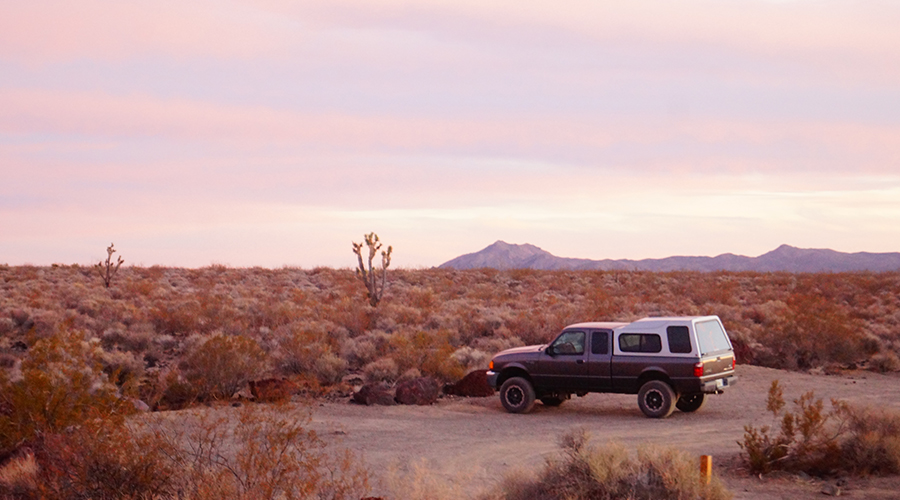
Each of the roads is different with varying road conditions as well as unique features to be seen from each. Here are a few Joshua Tree backcountry roads as well as what you can expect to see on them.
- Covington Flat
- You can take this road to the top of Eureka Peak for views overlooking Palm Springs and the surrounding mountains. You can also find some of the largest of the parks Joshua Trees, pinyon pines and junipers.
- Geology Tour Road
- This is an 18 mile tour of the Joshua Tree landscape with 16 stops along the dirt road. Be sure to pick up a tour pamphlet. There are Joshua Trees and cool rock formations and also a backcountry board which gives you access to backpacking and backcountry camping. At the south end of the Geology Tour Road you can meet up with Berdoo Road.
- Old Dale Road
- This road passes through a sandy dry lake bed as well as through sandy washes and through rocky canyons. There are also side trails to abandoned mines. High clearance is recommended in addition to 4WD.
To set out on your backroads adventure through Joshua Tree, check out the national parks website here to orient yourself with the locations of the various backcountry roads to choose from. On the same site, the national park provides links where you can download topographic maps of the areas you’re interested in for free or purchase a print version.
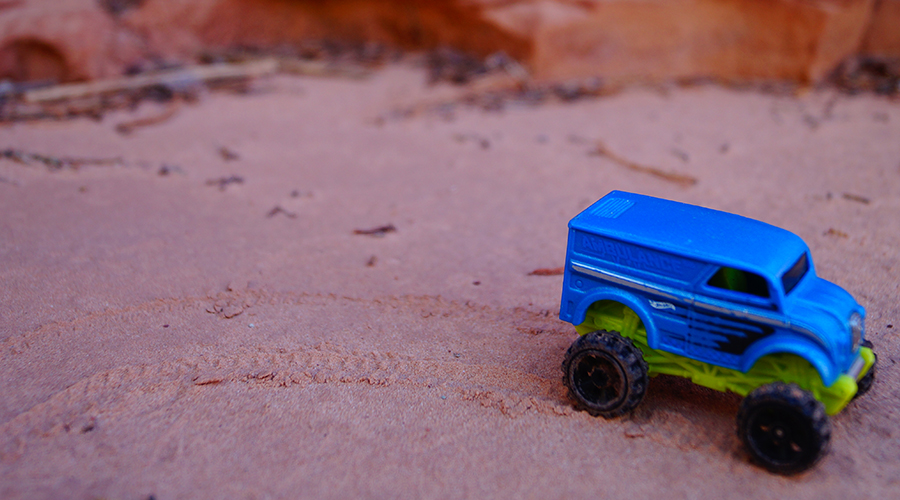
Ranger Programs in Joshua Tree
Joshua Tree National Park provides an opportunity to learn more about the park by joining the park rangers and volunteers on free guided walks and hikes, as well as free informational talks and evening programs. Some of the programs are repeating events and examples of topics covered include fossils, geology, Joshua Trees, and area history. There are also scheduled tours of the historical Keys Ranch (fee required: $10/adult and $5/senior and access pass holders, and children 6-11).
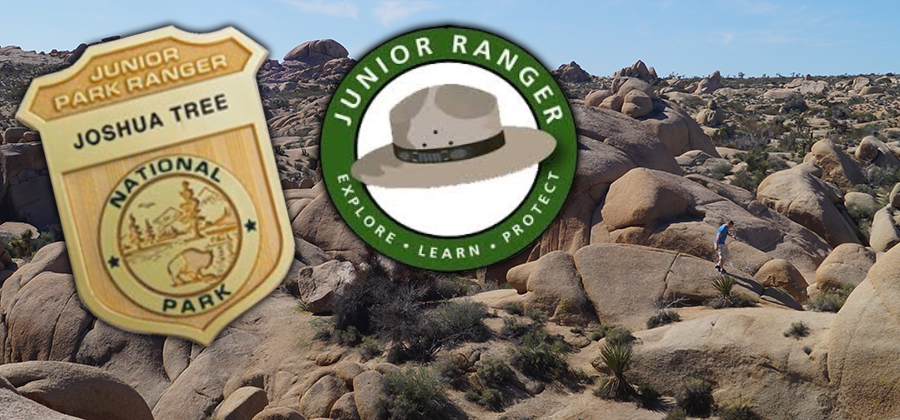
Consider the Ranger Programs when planning your trip to the park. They provide a great opportunity to gain a better understanding of the Joshua Tree National Park area, where the Mojave and Colorado Desert meet. Check out the Ranger Programs calendar of events on the national park website that provides information on which events are being offered, as well as where and when.
Wildflowers in Joshua Tree
Spring is a popular time of year to head to the desert in search of epic wildflowers and super blooms! To fully grasp the beauty of such an amazing spring time display, it’s definitely something you should see for yourself. Seeing the harsh brown rocky terrain of the desert floor covered in an unlikely exhibit of colors is just amazing. And if you look even more closely, you can see how many different kinds of flowers there are.
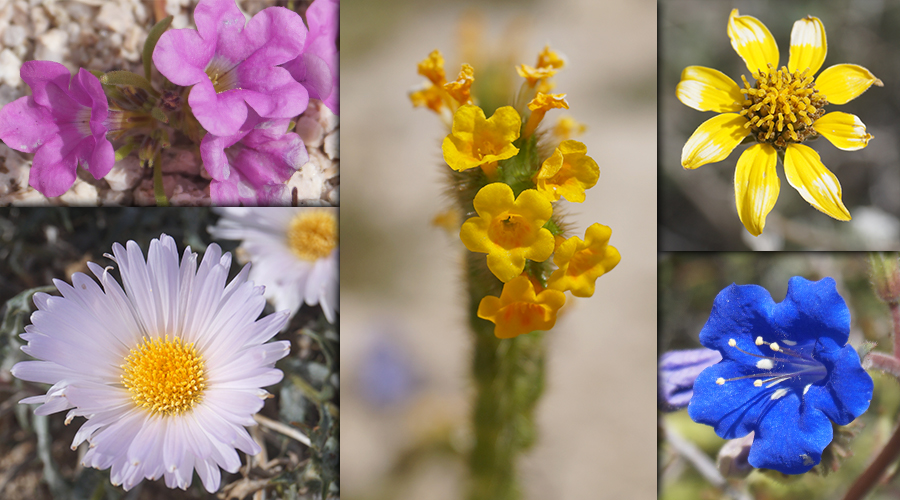
Of course, there are multiple factors that affect the turn out of wildflowers from year to year as well as when they will bloom. The precipitation in the fall and winter mixed with the temperatures in the spring are very important factors. Wildflowers throughout the park bloom between February and April, depending on the elevation. The wildflowers at lower elevations bloom earlier and the higher elevation wildflowers bloom into the later spring months.
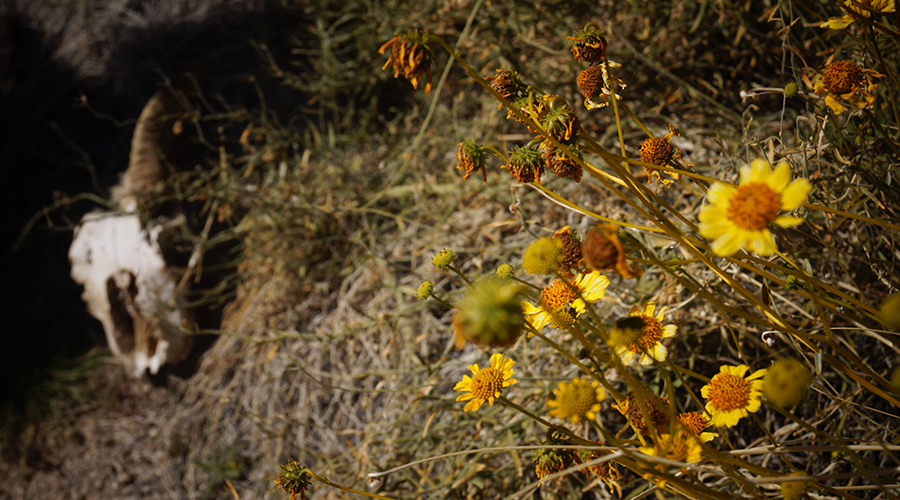
In 2019, the botanist Derrell Shade at Sky’s the Limit Observatory held a free special “Wildflower Discovery Days” event throughout March and April. For more information check out Sky’s the Limit website here.
What is a Joshua Tree?
Joshua Trees are not only given the honor of being the name of such an amazing national park but are also an iconic plant in its own right, but what is a Joshua Tree?
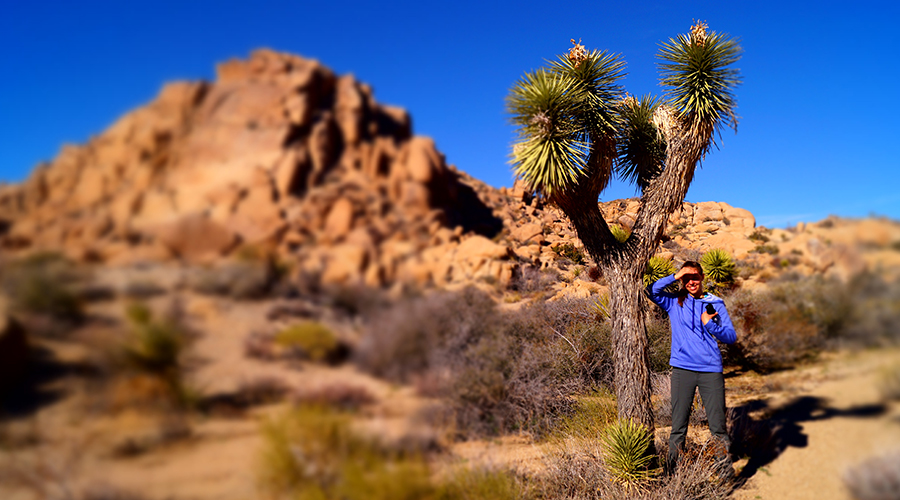
Joshua Tree (Yucca brevifolia) are a part of the Agave family and grow throughout the Southwest United States with a large percentage being in the Mojave Desert. They are dependent on timely precipitation as well as freezing winter temperatures to flower. Once they flower they are dependent on the yucca moth for pollination. Although Joshua Trees can sprout from existing branches and roots, in order to produce a separate organism the yucca moth is necessary.
Joshua Trees have varied unique and animated shapes and forms. Some have no branches and some have numerous which are believed to sprout after the flowering of a tree branch. The positions of the branches as you’re looking out into the desert make the Joshua Trees look as if they’re dancing and full of personality and individuality. Some people loathe the Joshua Tree but many find beauty, character and even inspiration from them. Beauty is truly in the eye of the beholder.
Joshua Tree National Park Visitor Centers
There are four separate visitor centers for Joshua Tree National Park. They all lie near the park boundaries and are good places to stop before heading into the depths of the park and the adventures waiting within. All of the visitor centers have exhibits, bookstores and flush toilets.
- Black Rock Nature Center
- Located in the Black Rock Campground
- Open October-May
- Saturday-Thursday: 8:00 am – 4:00 pm
- Friday: 8:00 am – 8:00 pm
- Water available
- Cottonwood Visitor Center
- Located near Cottonwood Spring at the south entrance
- Open 8:30 am – 4:00 pm
- Water available
- Joshua Tree Visitor Center
- Near the Joshua Tree park entrance
- Open 8:00 am – 5:00 pm
- No water available
- Oasis Visitor Center
- Near the Twentynine Palms park entrance
- Open 8:30 am – 5:00 pm
- Water available
There is also a little visitor center/ranger station on Indian Cove Road as you’re heading into the campground that is very basic. Even so, I thought it important to note that there are restrooms and water available here.
Another side note, at the corner of the CA-62 and Park Blvd near the Joshua Tree Visitor Center there is a very cool and friendly sort of multi purpose store called Coyote Corner. I’m mentioning this because they have very helpful products and services that may help you with your experience in the area. There are books and maps, camping gear and supplies, and coin operated showers that can come in very handy!
Joshua Tree National Park Map
At the entrance booths to the park, the rangers have informative brochures and park maps with many of the sought after points of interest. You can find a digital version of the brochure map here.
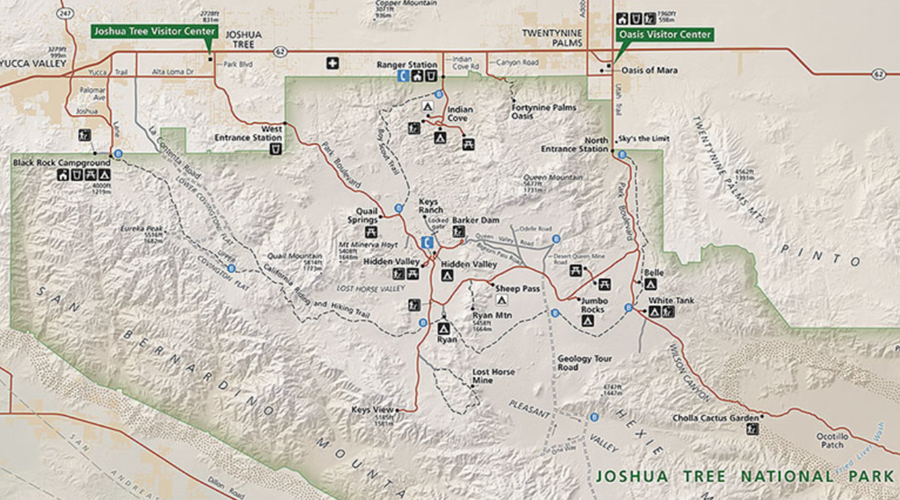
There are also very useful, detailed topographic area maps available on the National Park website that are free to download or are available for purchase in print. On the same website you can find maps of each of the Joshua Tree Campgrounds as well.
Joshua Tree National Park Weather
Desert weather can be unbelievably windy, scorching hot and unrelentingly dry. And freezing winter temperatures are critical for the survival of the Joshua Trees. But, temperatures reaching into the 60’s throughout the winter? Sold!
The weather in Joshua Tree National Park, with the exception of summer, is typically dry and sunny with averages in the 60’s and 70’s. Late Spring and early Fall hit temperatures in the 80’s and then, of course, Summer temperatures easily reach 90’s and sometimes passes into the 100’s. The hot summer days make for great night temperatures, though!
- December-February: 62/39
- March-April: 74/46
- May: 85/55
- June-September: 95/67
- October: 81/52
- November: 70/43
As you can see, the weather can play a large role in determining when people choose to visit the park. The busy season in Joshua Tree National Park is October through May. The temperatures during these months allow for more comfortable camping and hiking conditions, at the cost of more crowds.
Although it may be hard to find a campsite during the busy season, solitude can still be found if you venture off from the most popular hikes and points of interest. Speaking of campsites, you may be wondering how to decide on which campground to stay in during your visit…look no further!
Best Campgrounds in Joshua Tree
What are the best campgrounds in Joshua Tree? All of them! Each of the campgrounds are situated in very Joshua Tree-esque settings. Depending on what you want out of your trip to the national park, some campgrounds may cater more conveniently to certain points of interest, specific trails, or particular activities. Luckily, there aren’t any that would be a drag to stay at.
Actually, sometimes just scoring a spot at any campground in the park is a treat! During the busy season (October-May) all of the campgrounds are oftentimes completely full, especially on weekends. To see what other options you have for where to stay in Joshua Tree, click here.
Now, on to the highly sought after campgrounds in Joshua Tree!
Campgrounds with Busy Season Reservations
The following four campgrounds require reservations during the busy season between the months of October through May. Reservations can be made at www.recreation.gov. In the off season, they are first come, first served.
- Jumbo Rocks ($15)
- pit toilets/no water available
- 124 sites, camp between huge rock formations, enjoy rock scrambling for all skill levels, near Skull Rock Trail
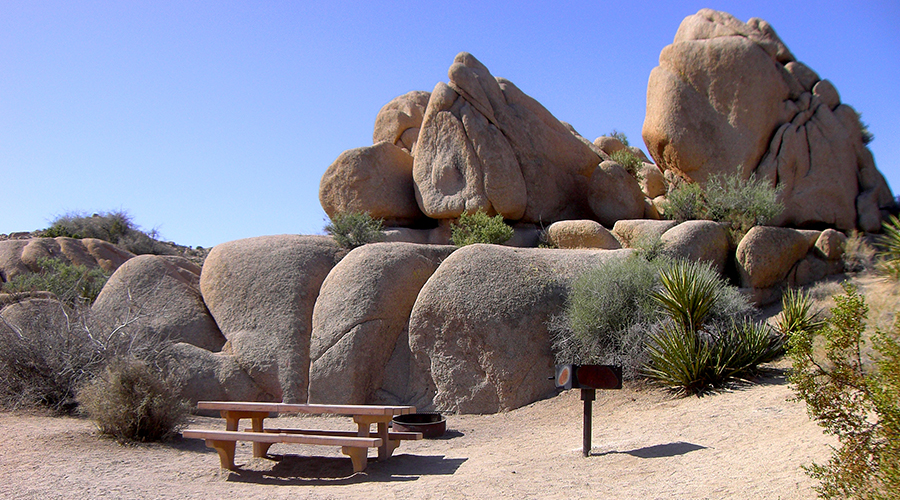
- Indian Cove ($20)
- pit toilets/water is available at the ranger station at the entrance
- 101 sites, sits among massive rocks, rock climbing and scrambling opportunities for days, near Rattlesnake Canyon
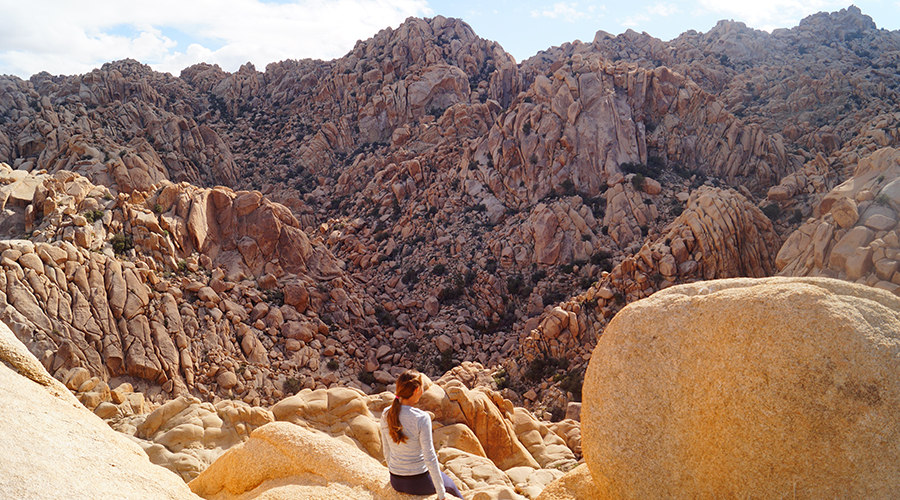
- Cottonwood ($20)
- flush toilets/water available
- 62 sites, nearby visitor center, dark skies for stargazing, near Lost Palm Oasis Trail
- Black Rock ($20)
- flush toilets/water available
- 99 sites, five miles from town, nature center, equestrian camp and trails
First-Come, First-Served Campgrounds
Meanwhile, the following campgrounds are first come, first served year round.
- Ryan ($15)
- pit toilets/no water available
- 31 sites, large boulders for climbing and scrambling, 4 equestrian sites by reservation
- White Tank ($15)
- pit toilets/no water available
- 15 sites, dark night sky area, huge boulders, Arch Rock Nature Trail
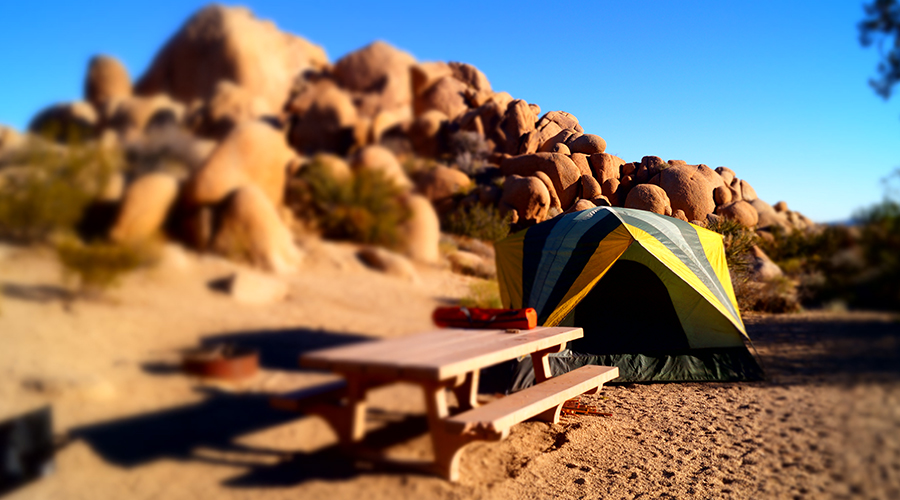
- Belle ($15)
- pit toilets/no water available
- 18 sites, dark night sky area, large rock piles
- Hidden Valley ($15)
- pit toilets/no water available
- 44 sites, lots of big rocks, rock climbing and scrambling, near Barker Dam Hiking Trail
Quick note, the campgrounds have a six person maximum per site. There is also a two vehicle maximum, though some sites only have space for one.
Joshua Tree Group Campsites
In addition to these campgrounds options, Joshua Tree National Park also has three group camp sites. The group camp sites can accommodate 10-60 people and these sites require a reservation to use. They can be reserved up to a year in advance.
- Cottonwood: tent only
- Sheep Pass: tent only
- Indian Cove: tent or small rig with combined max length of 25 feet
Another thing to note, campfires are allowed in the designated fire rings that are provided in each of the campgrounds but be sure to bring your own firewood. Gathering is prohibited.
Camping in Joshua Tree National Park really helps add to the experience of visiting the park. It’s super awesome to stay in a campground where your tent is surrounded by giant boulders. Why? To begin with, being able to wake up and immediately go for a climb, or eating your breakfast with a great view of the surrounding rock formations all without even having to drive anywhere! Not to mention, the convenience of having nearby trails for going on cool night hikes. And of course, many of the campgrounds are centrally located to a number of the must see trails and points of interest.
If you can only visit during the busy season and can’t secure a spot in the campgrounds or you just want to experience the area a different way, there are several other options!
Where to Stay in Joshua Tree
Although the campgrounds in Joshua Tree offer a pretty amazing experience, there are plenty of other options to keep in mind. Just as there’s a hike for everyone in Joshua Tree, there are also numerous types of accommodations available.
Backcountry Camping
Backcountry camping in Joshua Tree is another way to experience camping in the national park. This method requires a little more effort for an extra dose of peace, solitude and adventure. Following the guidelines below, this option allows you to camp out in the wilderness and also opens up backpacking opportunities in the park.
To backcountry camp, you must have a (free) backcountry permit. These can be picked up at any of the visitor centers, ranger stations, or one of the 13 designated backcountry boards scattered throughout the park. At each of these boards, there is a parking spot for your vehicle, an information panel, as well as a box to deposit the bottom portion of your permit.
When choosing your backcountry campsite, you must be at least one mile from any trailhead or road and 500 feet from trails and water sources. Also, try to choose spots that will create the least amount of impact on the area.
As rewarding as this camping method can be, it takes more effort not only to get to but also to plan. Fires are prohibited so plan your meals accordingly, bring plenty of layers, and pack enough water.
Dispersed Camping on Nearby BLM Land
BLM (Bureau of Land Management) land is public land that is open to dispersed camping. Dispersed camping is very basic. These areas are completely undeveloped meaning there are no toilets, water or trash cans so plan accordingly. Pack everything out with you.
Campfires require that you get a permit from a BLM office or online by clicking here.
Conveniently, there are areas of BLM land to the north and the south of Joshua Tree National Park. Click here for a map of these designated BLM areas from the national park web
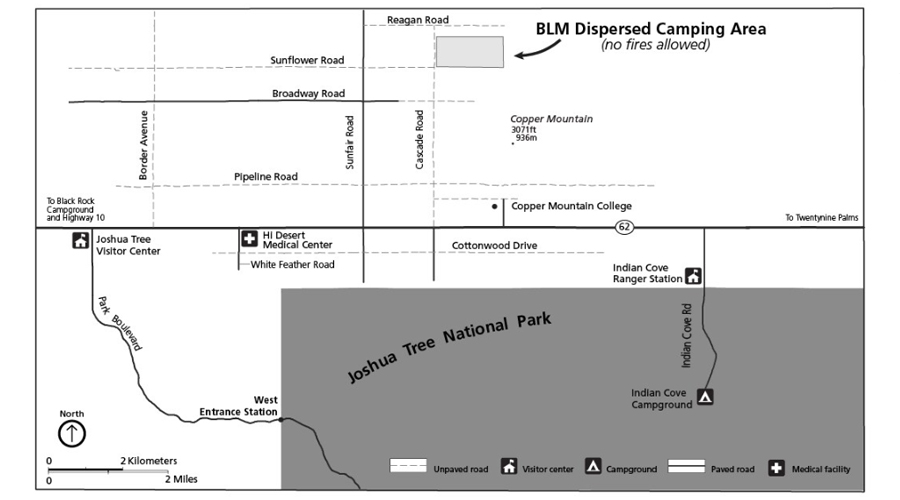
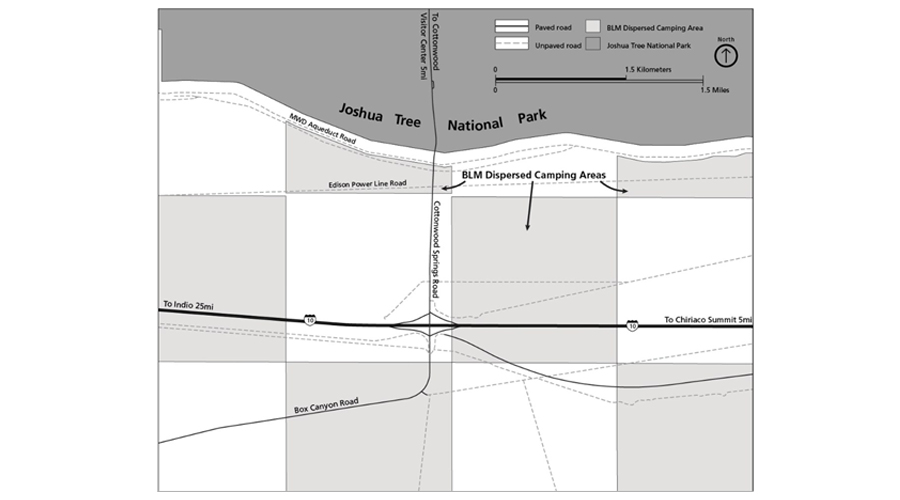
BLM Dispersed Camping to the South of Joshua Tree National Park
Joshua Tree Hotels
There are no hotels within the boundaries of Joshua Tree National Park. That being said, there are areas outside of the national park that are well developed. There are hotel/motel options near to all of the entrances of the national park. Although, if you’re coming in the south entrance the hotels are a bit further distance from the entrance to Joshua Tree National Park.
- Joshua Tree Hotels
- Joshua Tree Inn: (760) 366-1188
- Safari Motor Inn: (760) 366-1113
- High Desert Motel: (760) 366-1978
- Yucca Valley Hotels
- Travelodge Inn and Suites: (760) 365-3311
- America’s Best Value Inn: (760) 418-5900
- Best Western Hotel and Suites: (760) 365-3555
- Twentynine Palms Hotels
- Best Western Gardens Hotel: (760) 367-9141
- El Rancho Dolores Motel: (760) 367-3528
- Motel 6: (760) 904-6992
- Indio Hotels
Joshua Tree RV Camping
If you’ve got a big rig, can’t secure a spot in the park or just prefer having hookups and facilities, there are numerous campgrounds outside of Joshua Tree National Park. Here are a few campgrounds in the area that you can call home after hiking in Joshua Tree:
- Joshua Tree Lake RV and Campground: (760) 366-1213
- Twentynine Palms RV Resort: (760) 367-3320
- Palm Springs/Joshua Tree KOA: (760) 251-6555
Joshua Tree airbnb
This has become an increasingly popular way to book a unique stay in the Joshua Tree area and a great hotel/motel alternative. Prices vary as well as the spaces available for rent and there are literally hundreds of options.
Some examples of spaces that you can book on airbnb include: entire houses, desert cabins, campers, bungalows, guest houses, tiny houses, unique tents, a room in a house, apartment, and more.
By booking spaces such as these, you choose the vibe of your desert experience as each property has it’s own unique feel and perks. Some places offer pools, hot tubs, kitchens, telescopes, washer/dryer, wifi and the options vary as each property has it’s own special touch! Here are a few pictures of the Air bnb Casa De Agave.
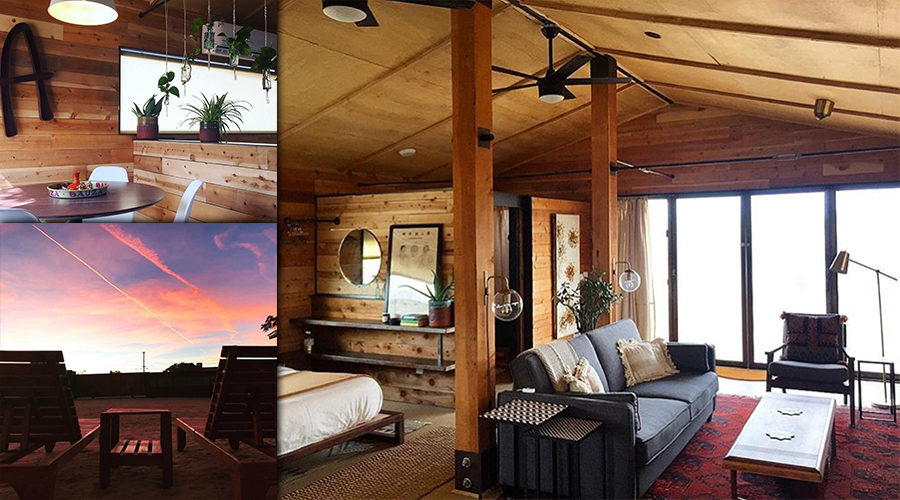
As you can see, there are endless ways and places to plan your stay when coming to Joshua Tree National Park. The numerous options really allow you to cater to your own desires of experiencing the one-of-a-kind Joshua Tree area.
Restaurants in Joshua Tree
After you’ve finished up a day of hiking in Joshua Tree you’ve no doubt had a day full of beauty, full of fun, and full of adventure but now you’re running on empty. Don’t worry because there are a number of great restaurants near Joshua Tree to choose from. There is also a surprising variety of atmospheres and cousines to decide upon as well.
- Pie for the People: (760) 366-0400
- Joshua Tree Saloon: (760) 366-2250
- The Rib Co.: (760) 367-1663
- Edchada’s: (760) 367-2131
- Thai Cafe: (760) 865-0737
- Little Italy Italian Cafe: (760) 820-1268
Like this article? Pin it!
The Adventure Continues!
If you loved your experience in Joshua Tree National Park and have more time to play in the surrounding area, you’re in luck! Here are a few places in the vicinity you may want to check out.
- Pioneertown
- Mojave National Preserve
- Salton Sea
- Anza Borrego State Park
- Johnson Valley
- Big Morongo Canyon Preserve
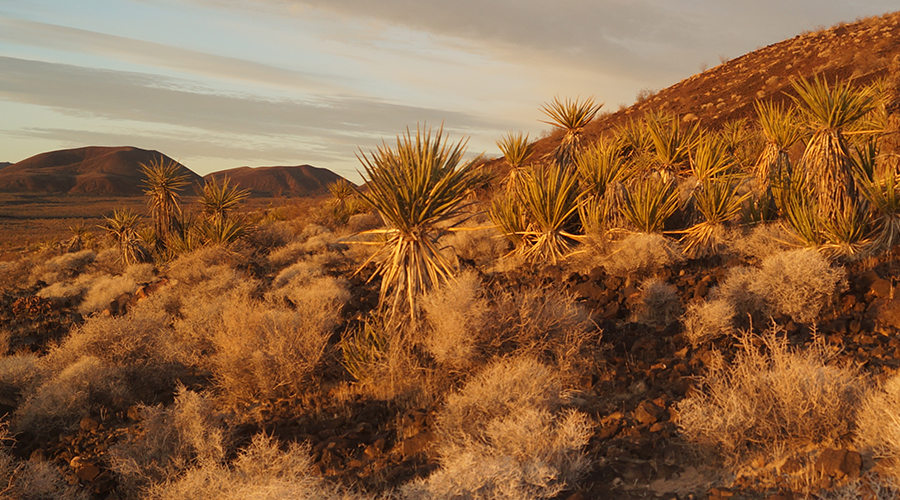
Also, when you’re packing for your trip to Joshua Tree, don’t forget your longboard! There are some fun hills to bomb and neighborhoods to cruise not far from the national park. There are also numerous skate parks nearby as well as in the surrounding areas.
- Western Hills Estates Neighborhood
- Sage Estates Neighborhood
- Twentynine Palms Skate Park
- Yucca Valley Skate Park
- Alliance Skate Park in Palm Springs
- Civic Center Skate Park in Palm Desert
Thanks for reading The Lost Longboarder’s Hiking in Joshua Tree Guide! We hope that you found lots of useful information in this guide and are gearing up for your own incredible Joshua Tree experience. Let us know if you have any further questions, if you discovered an amazing hike you want to tell us about or if you had your own successful Joshua Tree adventure. We’d love to hear about it!
If you’re interested in showing some support for The Lost Longboarder, check our our skate shop! Head over to Lost Coast Longboarding to get your hands on one of our hand painted longboards or our own silk screened t-shirts!
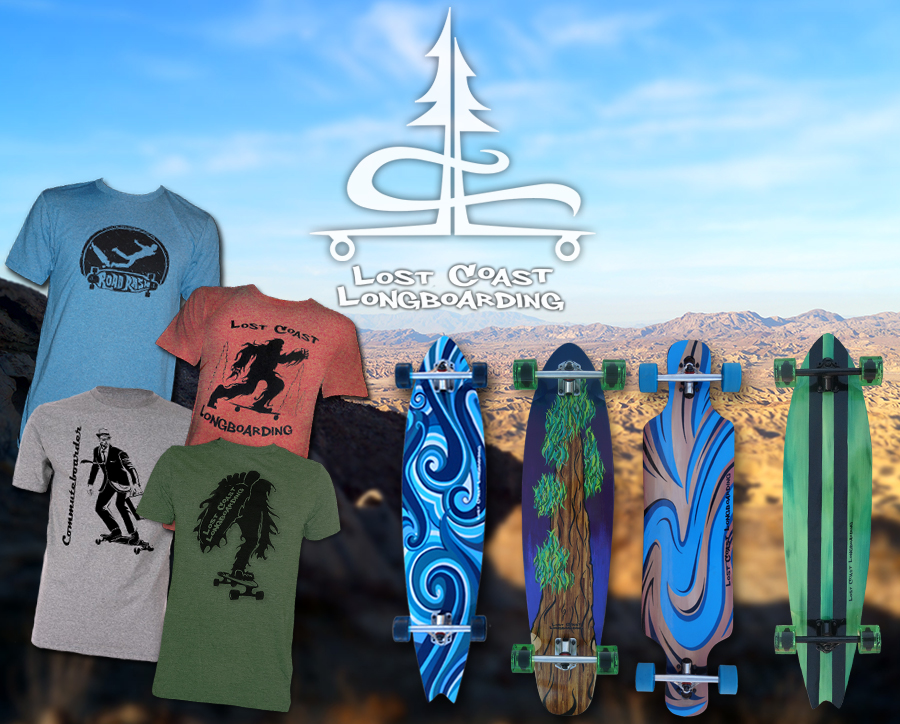
If you are not on the market for a new longboard, but still want to help us out, you still can! Do you shop on Amazon? Click here or the image below to get to Amazon.com and shop as normal, your experience on Amazon will not change, but it will help us out. Thanks!
